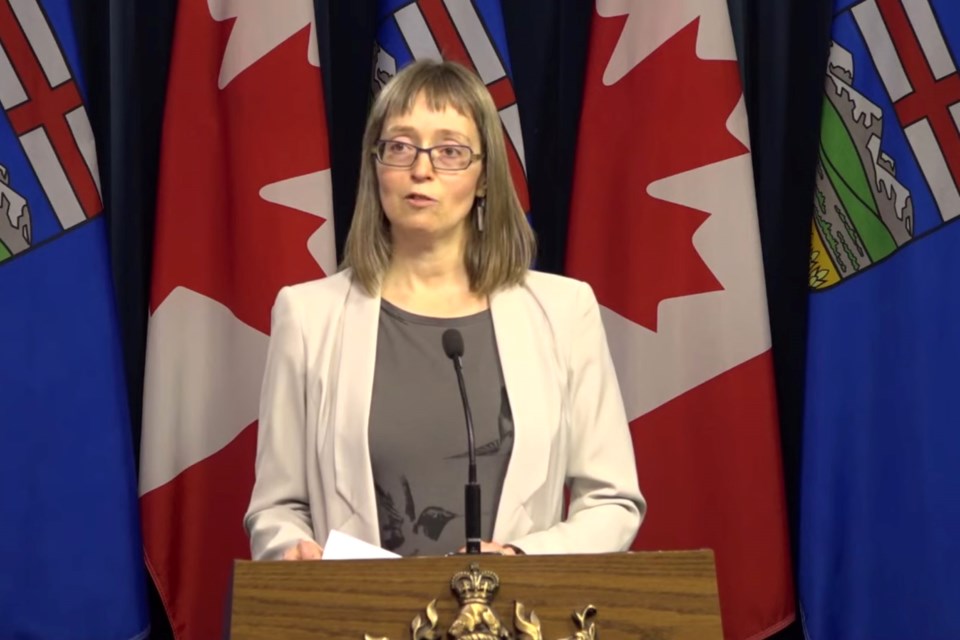While the novel coronavirus continues to make international headlines, Alberta’s chief medical officer is cautioning residents about a virus posing a greater threat to Albertans: the flu.
Dr. Deena Hinshaw said there are “zero probable, zero confirmed” cases of the coronavirus in the province, and reiterated that the threat to Albertans is still low. The most recent update on Jan. 30 came as the World Health Organization (WHO) declared an emergency over the respiratory illness.
“There are no probable or confirmed cases in Alberta at this time,” Hinshaw said. The WHO's emergency declaration only ensures international co-ordination in response to the outbreak, she added, but it "doesn't change" day-to-day life for Albertans.
"I know that many Albertans feel anxious about the novel coronavirus. When people feel worried about a new health threat, it’s important to get information from reliable sources."
The cases confirmed so far in Ontario and B.C. are travel-related, and if the province does see a confirmed case, Alberta has a contagion plan in place to prevent further spread, Hinshaw said.
READ MORE: Symptoms, diagnosis of coronavirus
Some Albertans have been tested or isolated for possible coronavirus, Hinshaw said, but there are still no confirmed cases in the province.
Patients with the coronavirus report mild to severe respiratory illness with symptoms of fever, cough, and shortness of breath.
The virus is believed to be spread by respiratory droplets, just like the common cold, and can be prevented by using good hygiene practices like frequent hand-washing and using alcohol-based hand rubs. These methods are much more effective than wearing a face mask, Hinshaw said.
Anyone who has symptoms of a respiratory infection and has travelled to Wuhan, China, should call the Health Link hotline at 811.
Are we prepared?
Preparation for a potential case here has been ongoing for several weeks, Hinshaw said. Alberta Health Services (AHS) is working closely with the Public Health Agency of Canada to inform healthcare workers on the front lines on what questions and symptoms to watch for, including the patient's travel history.
"We have proven processes and well-trained teams in place to both protect the public and respond if a travel-related case should occur in our province," Hinshaw said.
If the person had travelled to an area of concern, Hinshaw said they're taken into a private room and given a nasopharyngeal swab test. AHS can also make arrangements for people to have a test done in their own homes instead of a health care centre.
While the test results are waiting to come back, the person would be put into isolation.
If the person is well enough to go home, they're given instruction to stay inside and monitor their symptoms until they receive the results of their test, which can take one to two days to process, Hinshaw said. If hospital care is needed, the patient would be put into a separate room and cared for by healthcare workers wearing face masks, eye protection, gown and gloves.
Conversations around if additional measures are needed are happening between AHS, Public Health and other jurisdictions across Canada as well.
Flu still a serious disease
A large part of why people are afraid of the coronavirus is because it's new, Hinshaw said.
"It's really natural that when we see a new threat to our health, we worry about it – just as it's human nature to not be as worried about things we're familiar with."
Most of the time when the test results come back, even in cases of people who had travelled to China, the cause of their symptoms is because of another virus, she said. It's much more likely for Albertans to catch the flu.
"The risk is greater because we have influenza circulating widely in the province. We have many thousands of cases, and those are just the cases who've been diagnosed," she said. "Many people who have influenza never go to see a doctor to get tested."
According to the latest data from AHS, there have been 4,198 confirmed influenza cases over the last six months in the province, out of a total population of 4.3 million. Nineteen people have died from influenza over the same time period.
Influenza deaths are higher in the Edmonton zone, which includes St. Albert, than anywhere else in the province. So far, there have been 973 reported cases of influenza and 10 deaths in a population of 1.2 million – and those numbers are relatively normal.
Over the same time period last year, there were 925 confirmed cases of the flu with five recorded deaths.
READ MORE: Flu shot a better match than last year: AHS
"Even though it's an average year, influenza is still a serious disease," Hinshaw said.
Symptoms of the flu include fever, aching muscles, headache, fatigue, chills and a sore throat.
The National Advisory Committee on Immunization recommends anyone older than six months old, and who does not have a contraindication (a specific situation where the shot might be harmful) to the flu shot, receive a vaccine.
This year, AHS is seeing higher rates of immunization when compared to the same time last year, which Hinshaw said was "encouraging to see."
So far, there have been 442,234 doses of vaccines administered in the Edmonton zone, compared to the 412,866 doses of vaccines administered over the same period last year.




